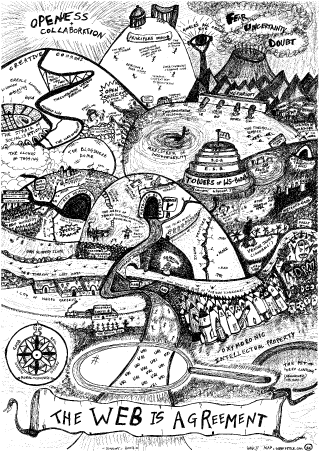With the explosion of web-enabled devices of all shapes and sizes, the practice of web design and development seems more complex than ever. But if we can learn to see below this overwhelming surface to the underlying web beneath, we can learn to make sites not for specific devices but for the people using them. This presentation will demonstrate how tried and tested principles like REST and progressive enhancement are more important than ever. By embracing the spirit of the web, you can ensure that your websites are backwards compatible and future friendly.

The IT Crowd - Series 3 - Episode 4: The Internet
How Much Does The Internet Weigh?
The Web Is Agreement by Paul Downey.
Classic HTTP Documents at the W3C.
HTTP — an application-level protocol on Dev.Opera.
Google Web Accelerator: Hey, not so fast - an alert for web app designers on Signal vs. Noise, the 37 Signals blog.
Styling buttons to look like links by Natalie Downe.
Cyberspace. A consensual hallucination experienced daily by billions of legitimate operators, in every nation, by children being taught mathematical concepts… A graphic representation of data abstracted from banks of every computer in the human system. Unthinkable complexity. Lines of light ranged in the nonspace of the mind, clusters and constellations of data. Like city lights, receding.Neuromancer by William Gibson
We demand rigidly-defined areas of doubt and uncertainty.The Hitchhiker’s Guide to the Galaxy by Douglas Adams
There are known knowns. These are things we know that we know. There are known unknowns. That is to say, there are things that we know we don’t know. But there are also unknown unknowns. There are things we don’t know we don’t know.Donald Rumsfeld
The control which designers know in the print medium, and often desire in the web medium, is simply a function of the limitation of the printed page. We should embrace the fact that the web doesn’t have the same constraints, and design for this flexibility.A Dao of Web Design by John Allsopp
Style Tiles by Samantha Warren.
Adactio: Journal—Pattern Primer
Adactio: Journal—Sharing pattern libraries
It’s my belief that in order to embrace designing native layouts for the web – whatever the device – we need to shed the notion that we create layouts from a canvas in. We need to flip it on its head, and create layouts from the content out.A Richer Canvas by Mark Boulton
My love for responsive centers around the idea that my website will meet you wherever you are—from mobile to full-blown desktop and anywhere in between.Fit to Scale by Trent Walton
The World Wide Web Project (the first web page ever published)
The web is responsive on its own—by default. It’s us that’s been breaking it all these years by placing content in fixed-width containers.Responsive by Default by Andy Hume

The dirty little secret is that the more you test—the more accurately you will determine when it’s ok not to.The value of 1000 Androids by Stephanie Rieger

There is a difference between support and optimization.Brad Frost
Responsive Images: How they Almost Worked and What We Need by Mat Marquis.
A framework for discussing responsive images solutions by Jason Grigsby.
Which responsive images solution should you use? by Chris Coyier.
Responsive Images Community Group
Responsive image format by Yoav Weiss.
Perhaps ironically the more backwards compatible your web site is, the more future friendly it is.Luke Wroblewski
If you could only do one thing to prepare your desktop site for mobile and had to choose between employing media queries to make it look good on a mobile device or optimizing the site for performance, you would be better served by making the desktop site blazingly fast.Jason Grigsby
Steve Souders—High Performance Websites
Stop solving problems you don’t yet have by Rachel Andrew.
24 Ways: Conditional Loading for Responsive Designs

How many ways can you slice a URL and name the pieces? by Tantek Çelik.
The protocol-relative URL by Paul Irish.
Adactio: Journal—A matter of protocol
Every piece of knowledge must have a single, unambiguous, authoritative representation within a system.The DRY principle
URLs are universal. They work in Firefox, Chrome, Safari, Internet Explorer, cURL, wget, your iPhone, Android and even written down on sticky notes. They are the one universal syntax of the web.Kyle Kneath
Cool URIs don’t change.Tim Berners-Lee